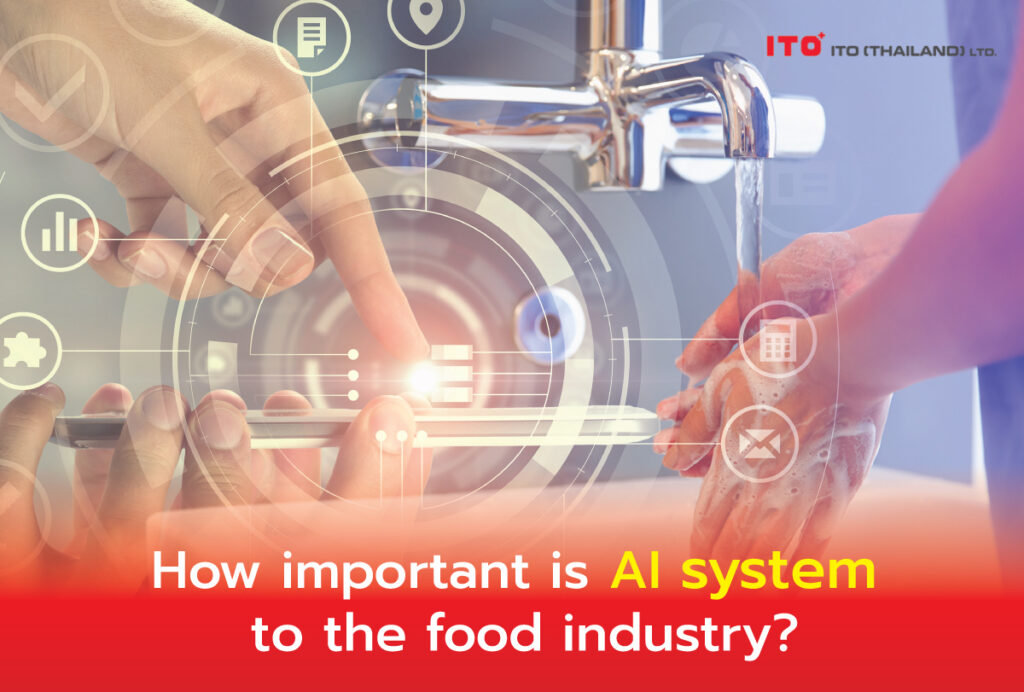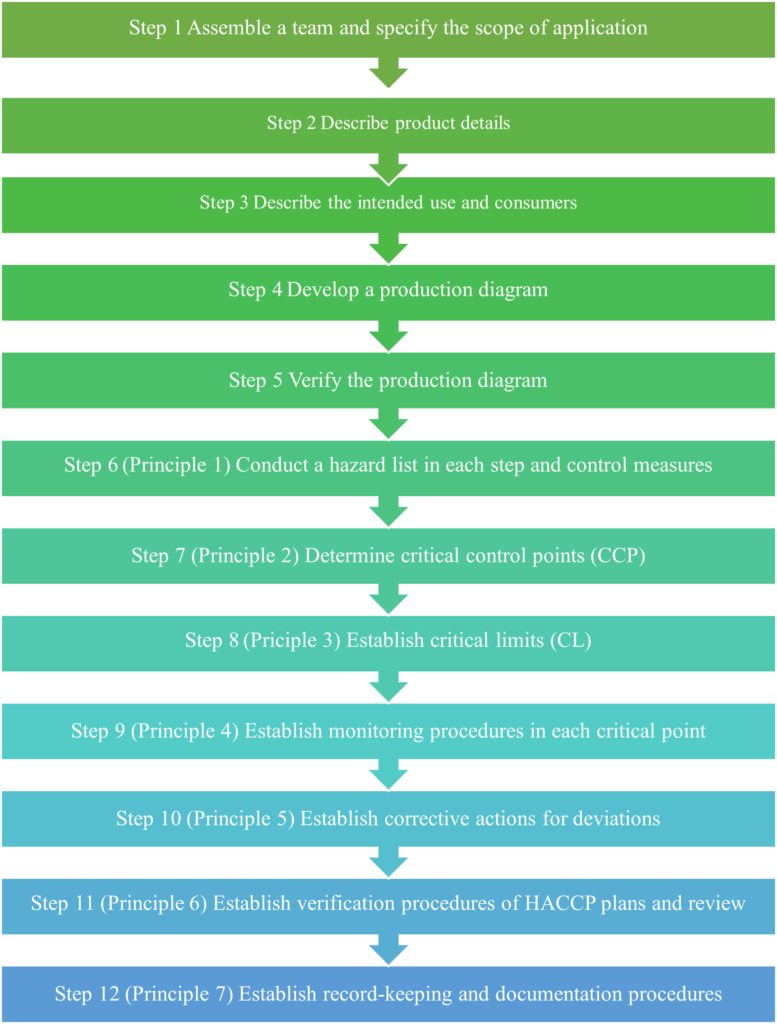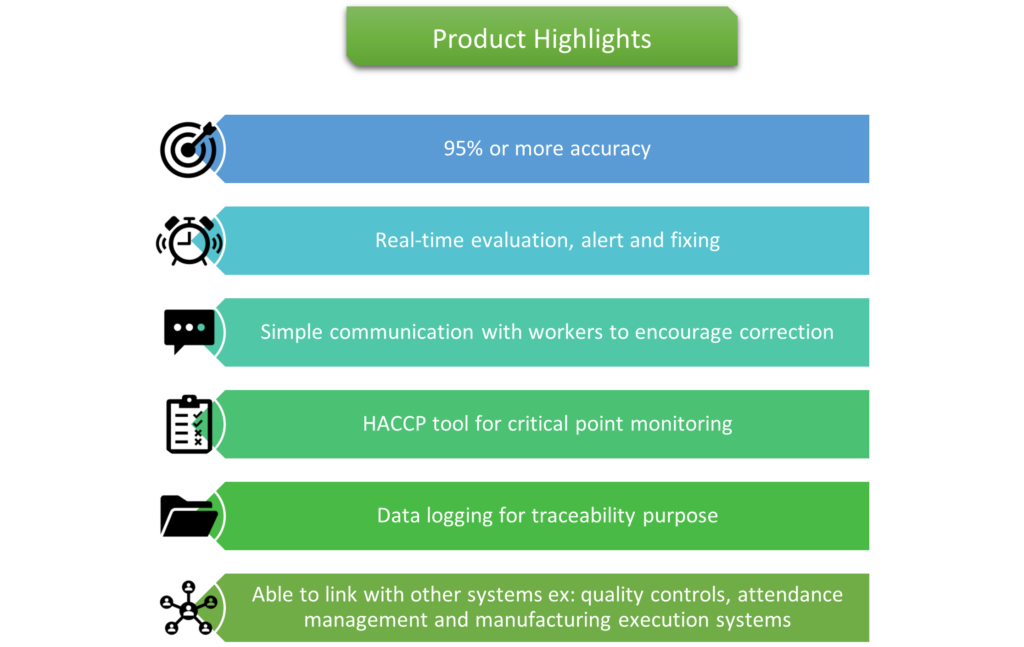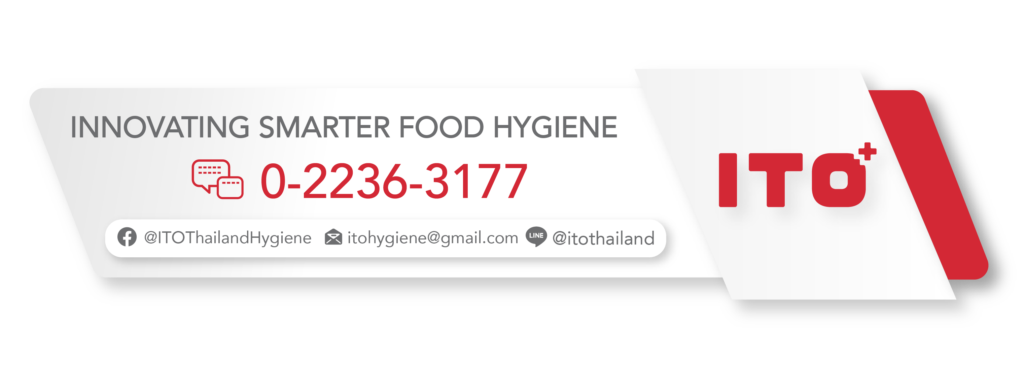ITO Thailand Hygiene Blog
AI technology in Food industry world
Food outbreak cases
At present, food safety and contamination issues continue to exist. According to the latest statistics from the Division of Epidemiology(1) , Department of Disease Control, 55,649 cases of food poisoning were found in 2021, of which 1 person died, and during January-March 2022, there were 13,213 cumulative cases. Examples of notable cases in the past year are: An outbreak of food poisoning in the eastern region in early 2022 was found to be caused by norovirus contamination(2) , or the latest news(3) in July 2022 where more than 250 people suffered from food poisoning from eating lunch boxes at a funeral, etc., o the same problem was also encountered overseas. In Japan(4) , pathogens of Staphylococcus aureus were found at a restaurant in Yamaguchi Prefecture and a ramen shop in Tochigi Prefecture in 2020. These dangerous contaminations can also occur in food products in addition to restaurants. In only the first half of 2022, there were product recalls that became a hot issue globally – a recall of peanut butter by U.S. Food and Drug Administration (USFDA) in the United States(5) , and a recall of chocolate products in European countries(6) by England’s Food Standards Agency (FSA) as both cases might have Salmonella contamination. There were also warnings(7) issued by China’s General Administration of Customs, Oman’s Ministry of Health, and Saudi Food and Drug Authority regarding powered infant formula possibly contaminated with bacteria resulting in deaths and an eventual product recall. These instances illustrate food safety issues that are dangerous to consumers as well as damage incurred to food producers in compensation, product recall, possible prosecutions, and factory shutdown. The contamination in the powdered infant formula prompted the American facility to be closed for inspection from February 2022 to June 2022, causing powdered formula shortage in the United States (8).
You can see that food safety is very important because it poses a risk to the health of consumers who are citizens of the country. As a result, each country has to set standards on hygienic production to keep food safe or for food to be imported into the country. For the law in Thailand, hygiene standards in production must be enforced, and inspections must be passed before setting up a factory or food production facility. For exports, different standards may be applied or required according to the end customer.
Upgrading of standards and the introduction of HACCP
In Thailand, generally, food production operations must pass the standards on food production methods, production tools and equipment, and storage according to the Notification of the Ministry of Public Health (No. 420) B.E. 2563 or commonly known as GMP 420 which defines the place of production, tools and equipment, production process control, sanitation, and personal hygienic conditions. However, the international GMP of Codex, currently known as GHP, has revised the scope of application from only production processes to the entire supply chain, and updated information (such as allergens) and explanations. GHP Codex will be part of the standards known as CXC 1-1969 where the Hazard Analysis and Critical Control Points (HACCP) will also be mentioned simultaneously. The most recent version enforced since 2020 will talk about good hygiene practices in Chapter 1 and HACCP in Chapter 2. Therefore, the upgrade from the preliminary GMP 420 enforced according to the Thai laws to GHP Codex will require an addition of HACCP. The standard upgrade does not only boost the consumer or customer confidence, but it also prevents valuable resources in the production such as raw materials, labor, time, and disposal of waste caused by errors in the production processes.
What is HACCP?
HACCP or Hazard Analysis and Critical Control Points for food production focus on preventing hazards of food production that will affect consumers. Currently, (Revision 2020(9) ) the hazards are categorized into 4 types: Physical (e.g., contamination of metal, glass shards, various contaminants), chemical (e.g., cleaning agents, lubricants, chemical contaminants, food additives that exceed the specified amount, antibiotics in raw materials), biological (e.g., cross-contamination of pathogenic microorganisms or microorganisms producing toxins) and the hazards of allergens. To put it briefly, HACCP consist of 12 steps and 7 principles, which can be summarized as shown in the diagram below.
Apart from implementing the 12 steps, training for relevant personnel within the organization must also be designed so that the HACCP plan implementation achieves higher efficiency.
Importance of handwashing
One of the critical points and sources of food contamination is contamination from the hands of employees who cook or are involved in food processing. According to a report from the Centers for Disease Control and Prevention (CDC) in the United States(10) , up to 34% of foodborne illnesses are related to inadequate hand hygiene. There is also reported research among students in India(11) that proper handwashing will effectively help reduce the spread of germs that cause diarrhea as well as reducing the number of common microorganisms found on human skin (normal flora) by up to 54%. As for food factories and food processing facilities, a study(12) on cross-contamination of raw meat into ready-to-eat food products discovered that proper handwashing could reduce the incidence of E. coli by 34%. Additionally, another study on the causes of foodborne illness(13) outbreaks found that they were most associated with infected employees touching food with their bare hands, followed by inadequate hand hygiene and improper cleaning of equipment, tools, and utensils.
Therefore, cleaning and disinfecting the hands of employees who have to touch food is extremely important and is often one of the points susceptible to control errors and is one of the critical points for cross-contamination or is a carrier of microorganisms and other impurities into the food production process. Thus, attention must be paid to hygiene, cleaning and hand disinfection. This may require training and educating the employees so that they understand and realize the importance of handwashing. Also, rules and support of appropriate equipment and tools are necessary so that the employees can clean and disinfect their hands according to the defined standards. However, the problem encountered in actual practice is that despite training, sometimes the employees neglect properly washing their hands according to the defined standards due to the large number of employees entering and exiting the production line or the kitchen each day, and in one day they may enter and exit multiple times. It is also difficult to check or warn them to fix immediately because there is a rush. In addition, when it comes to training, there are restrictions on the duration or the training cycle which is infrequent due to time and budget constraints. As a result, new employees sometimes do not get accurate information about the importance of food hygiene as much they should.
Case Study: Using AI Technology to Control Handwashing Standards
Such problems are the background of technology that plays a role in assisting and controlling, such as AI technology (read more) to ensure that employees’ practices are in line with standards. For an example of a case study of the problem of controlling hand cleaning in accordance with the standards, Ito (Thailand) would like to present an aid of AI technology from Japan that can control handwashing to ensure that the standards are met. The technology, developed by Contec Co., Ltd., uses AI-powered 3D camera processing using reference standards based on 6 correct handwashing steps recommended by Japan’s Ministry of Health. The results showed that handwashing gestures (e.g., pressing soap, hand sanitizer, hand-rubbing, washing with water, etc.) can be checked with accuracy of over 95%.
The advantages of such technology are that employees can know the assessment immediately (real-time) from the monitor, allowing them to improve handwashing instantly when the monitor gives an alert, and they will also know the right duration without having to press a separate stopwatch. It is the introduction of technology as a monitoring and surveillance system so that measures to control hazards, namely handwashing and disinfection, to prevent biological hazards are in accordance with the defined standards in terms of the gestures of handwashing and the duration. In addition to serving as an aid in real-time evaluation and giving alerts to correct the gestures for the employees to wash their hands properly immediately, the technology can also assist in recording data, preparing statistics as evidence in the assessment, or even in case of complaints, the traceability will indicate whether the measures to prevent danger in this critical point are operating normally or not. This makes it possible to clarify doubts effectively. The data may also be used to plan the control to be more effective and better. Moreover, the technology can also be connected to other systems of the organization, such as the quality control system, the attendance recording system, and MES (Manufacturing Execution System), etc.
Click here to see product demo video
ITO (Thailand), Ltd. would like to be a part in the development of technology for the food industry for sustainable food safety. If you are interested in the AI technology for the food industry, you can contact us to receive advice on the preparation of the system immediately.
References
1.Department of Disease Control. 2022. Food poisoning. online: https://ddc.moph.go.th/uploads/publish/1262720220412075734.pdf
2.2022. DDC investigates food poisoning cases in Chantaburi, finds virus contamination, warns consumers to be cautious about what they eat. online: https://www.matichon.co.th/local/quality-life/news_3113792
3.Matichon. Lunchboxes at funeral cause 250 food poisoning cases, hospital finds they are infected with Covid-19. online: https://news.trueid.net/detail/YEJzDbP8RyWE
4.2020. The Amendment to Japan’s Food Sanitation Act and Methods of Food Sanitation Management Utilizing AI Technology. online: https://www.contec.com/support/blog/2020/201028_health-ai/
5.2022. Outbreak Investigation of Salmonella: Peanut Butter (May 2022). online: https://www.fda.gov/food/outbreaks-foodborne-illness/outbreak-investigation-salmonella-peanut-butter-may-2022
6.Food Standards Agency. 2022. Update 3: Ferrero recalls in the UK products intended for European market. online: https://www.food.gov.uk/news-alerts/alert/fsa-prin-22-2022-update-3
7.2022. China warns consumers not to use Abbott baby formula affected by recall. online: https://www.reuters.com/world/china/china-warns-consumers-not-use-abbott-baby-formula-affected-by-recall-2022-02-21/?fbclid=IwAR2FvSIfCmid7_3DnO2a9ZAndFS2csQT2tsFAnJHAOwtetbKxNo3EFrLNs0
8.Khushi A. 2022. Abbott says it has reopened Michigan baby formula plant. online: https://www.reuters.com/business/healthcare-pharmaceuticals/abbott-says-it-has-reopened-michigan-baby-formula-plant-2022-07-09/#:~:text=July%209%20(Reuters)%20%2D%20Abbott,producing%20specialty%20baby%20formula%20EleCare.
9.Codex Alimentarius. 2020. The General Principles of Food Hygiene (CXC 1 – 1969, Rev.5-2020). online: https://www.fao.org/fao-who-codexalimentarius/sh-proxy/en/?lnk=1&url=https%253A%252F%252Fworkspace.fao.org%252Fsites%252Fcodex%252FStandards%252FCXC%2B1-1969%252FCXC_001e.pdf
10.Craig B.S. nd. Information You Can Use Hand Washing Research. online: https://www.uidaho.edu/-/media/UIdaho-Responsive/Files/Extension/topic/germ-city/research-you-can-use.pdf
11.Tambekar, D. H., & Shirsat, S. D. (2009). Hand washing: a cornerstone to prevent the transmission of diarrhoeal infection. Asian J Med Sci, 1(3), 100-3.
12.Todd, E. C., Greig, J. D., Bartleson, C. A., & Michaels, B. S. (2009). Outbreaks where food workers have been implicated in the spread of foodborne disease. Part 6. Transmission and survival of pathogens in the food processing and preparation environment. Journal of food protection, 72(1), 202-219.
13.Todd, E. C., Greig, J. D., Bartleson, C. A., & Michaels, B. S. (2007). Outbreaks where food workers have been implicated in the spread of foodborne disease. Part 3. Factors contributing to outbreaks and description of outbreak categories. Journal of food protection, 70(9), 2199-2217.
Related Post
-

Liquid nitrogen in food industry
You maybe have heard that liquid nitrogen can rapidly freeze the food, haven’t you? And what are its advantages and benefits? Let's get to know the liquid nitrogen in food industry with ITO (Thailand).
-

Ultrafine bubble (UFB) technology (Part 2)
The previous content has discussed the benefits of the ultrafine bubble technology in agriculture, livestock, and fisheries, cleaning raw materials and various surfaces. Today, we will continue to learn about the use of the ultrafine bubble technology in food production processes and waste management from the food industry and how to create these tiny gas bubbles.
-

Ultrafine bubble (UFB) technology (Part 1)
Simple bubbles when transformed into the micro-nano level can do more than you think. Let's learn about the technology of these tiny bubbles and their application in the food industry with ITO (Thailand).
-
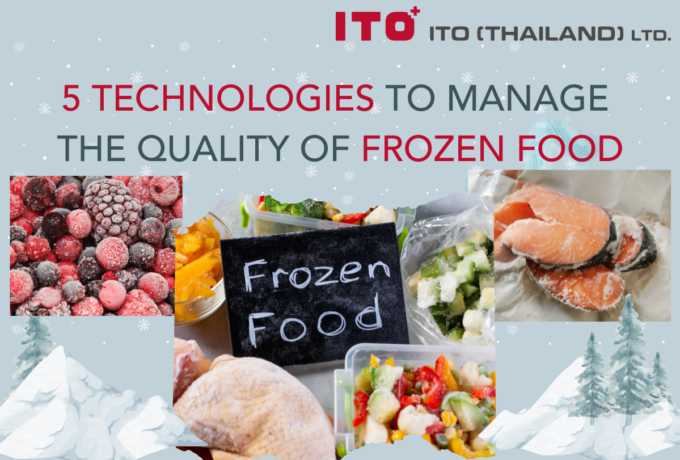
Frozen food storage management
Freezing is a method of food preservation commonly used in food that goes bad quickly such as ready-to-cook fresh food, ready meals, or foods in which nutritional values decay easily, or have substances that are sensitive to temperature, light, oxygen, etc. Freezing uses a principle of quickly solidifying water in the products, making the molecules of the substances unable to react to one another, thus the foods last longer. It also suppresses the growth of microorganisms and kills parasites. For instance, USFDA suggested controlling parasites in fish consumed raw such as sushi and sashimi by freezing the fish at the minimum of 20 degrees Celsius for 7 days or stored at -35 degrees Celsius for 15 hours to control parasites in fish (conditions may depend on the size of the fish as well).
-

Boot Cleaner
Pay attention to the hygiene of the footwear for good hygiene in the food industry
-
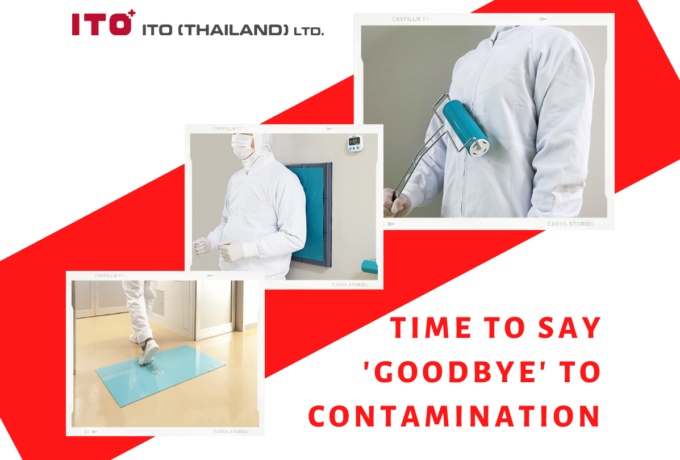
Innovation for sustainable physical contamination prevention
It is known that external impurities pose a food safety risk. One of the main channels of contamination is the presence of humans as a carrier of dust and dirt into the production or high-risk areas, causing dirt, germs, or foreign matters to contaminate food and harm consumers.








